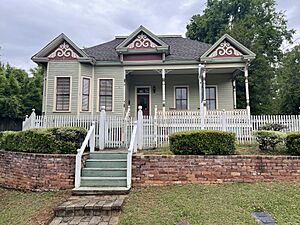Alma Thomas facts for kids
Quick facts for kids
Alma Thomas
|
|
|---|---|
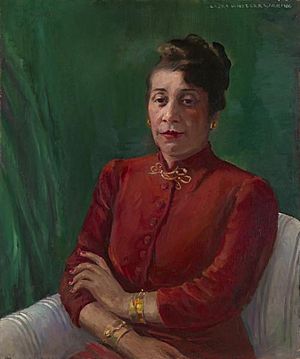
Portrait of a Lady (Alma Thomas), 1947 by Laura Wheeler Waring
|
|
| Born |
Alma Woodsey Thomas
September 22, 1891 Columbus, Georgia, U.S.
|
| Died | February 24, 1978 (aged 86) Washington, D.C.
|
| Education | Howard University Columbia University |
| Known for | Painting |
|
Notable work
|
Sky Light; Iris, Tulips, Jonquils and Crocuses; Watusi (Hard Edge); Wind and Crepe Myrtle Concerto; Air View of a Spring Nursery; Milky Way; Flowers at Jefferson Memorial; Untitled (Music Series); Red Rose Sonata; Breeze Rustling Through Fall Flowers; The Eclipse |
| Movement | Expressionism Realism |
Alma Woodsey Thomas (September 22, 1891 – February 24, 1978) was an amazing African-American artist and teacher. She was famous for her bright, abstract paintings. Alma didn't start painting full-time until she was almost 70 years old, after she retired from teaching. She became a successful artist even though she faced many challenges because she was an African-American woman during a time of segregation and unfair treatment. This makes her story truly inspiring!
Today, Alma is known as a very important American painter of the 20th century. Her beautiful paintings are shown in famous museums and collections. Many books have been written about her, and her art has been featured in special museum shows.
Contents
Alma Thomas's Early Life and Education
Alma Thomas was born on September 22, 1891, in Columbus, Georgia. She was the oldest of four daughters. Her father, John Harris Thomas, was a businessman, and her mother, Amelia Cantey Thomas, was a dress designer. Alma later wrote that her mother and aunts were teachers.
As a child, Alma loved to create things. She made small artworks like puppets, sculptures, and plates. She mostly used clay from the river near her home. Even though she loved art, Alma was not allowed to visit art museums when she was young. Instead, she took music lessons because her mother played the violin.
In 1907, when Alma was 16, her family moved to Washington, D.C. They moved to escape difficult times in Georgia and to find better public schools in Washington. Alma later explained, "When I finished grade school in Columbus, there was nowhere that I could continue my education, so my parents decided to move the family to Washington."
In Washington, Alma went to Armstrong Technical High School. This is where she took her very first art classes. She said, "When I entered the art room, it was like entering heaven. . . . The Armstrong High School laid the foundation for my life."
In high school, Alma was excellent at math and science. She was especially interested in architecture. She even made a tiny schoolhouse from cardboard using architecture skills, and it was shown at the Smithsonian in 1912. Alma wanted to be an architect, but it was very unusual for women to work in that field back then.
After high school in 1911, she studied kindergarten education at Miner Normal School. She earned her teaching certificate in 1913. She taught for a few months in Maryland and then in Delaware until 1921.
In 1921, at age 30, Alma started at Howard University. She began studying home economics, hoping to design costumes. But she soon switched to fine art after learning from James V. Herring, who started the art department. At Howard, she focused on sculpture. She earned her Bachelor of Science in Fine Arts in 1924.
Alma's Career as a Teacher and Artist
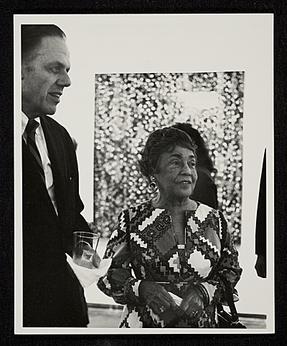
In 1924, Alma Thomas began teaching art at Shaw Junior High School. This was a school for Black students in Washington, D.C., which had separate schools at the time. She taught there until she retired in 1960. She once said, "I was there for thirty-five years and occupied the same classroom." While teaching, Alma continued to work on her art and learn more. She also stayed involved with the art community in Washington, D.C., often through Howard University.
During these years, Alma painted a lot, especially with watercolors. Her early paintings were more traditional and realistic. She was known as a "brilliant watercolorist." In the summers, she would travel to New York City to visit art museums like the Metropolitan Museum of Art and other galleries.
From 1930 to 1934, she attended Teachers College at Columbia University. She earned her Masters degree in Art Education in 1934. Her studies focused on sculpture, and she wrote her main paper about using marionettes (puppets). In 1935, she studied marionettes even more with a famous puppeteer named Tony Sarg.
In the 1940s, Alma also joined an artist group called "The Little Paris Group." This group was for Black artists in Washington. It was started by Lois Mailou Jones and Céline Marie Tabary, who were both artists and teachers at Howard University. The group met weekly at Jones's studio. It helped artists practice painting from models and improve their skills.
In 1958, Alma visited art centers in Europe with students from Temple University. This was a big art tour.
In 1950, when she was 59, Alma began studying at American University. She took night and weekend classes for ten years. She studied Art History and painting.
Alma Thomas's Artistic Journey
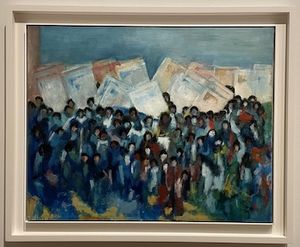
When Alma started her studies at American University in 1950, her painting style changed a lot. She moved from painting realistic figures to Cubism and then to Abstract Expressionism. She started using the bright colors that would become her famous style.
Within 12 years of her first class at American University, she began creating "Color Field" paintings. These were inspired by other abstract artists.
Alma often worked in her small living room, which was her home studio. She would prop her canvas on her lap and lean it against the sofa. She created works like Watusi (Hard Edge) (1963) in her kitchen. This painting was her own version of a famous artwork by Henri Matisse. Alma changed the shapes and colors and named it after a popular song.
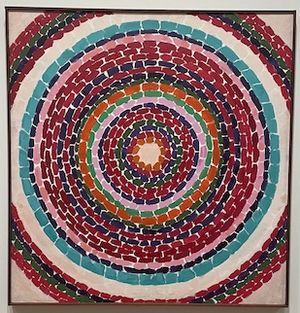

Unlike many other artists of her time, Alma did not use tape to make sharp outlines in her paintings. Instead, she drew light pencil lines across the canvas to create shapes and patterns. Then, she filled these areas with paint. You can often see her pencil lines in her finished artworks because she didn't erase them.
After she retired, Alma's art focused a lot on how colors work together. Her later paintings were inspired by space exploration and the universe. For example, her 1972 painting, 'Mars Dust,' was named after news stories about a dust storm on Mars. She wanted to focus on "beauty and happiness" in her art. She also said, "Color is life, and light is the mother of color."
Her first big art show was in 1966 at Howard University. It showed 34 of her works. For this show, she created her Earth Paintings, which were abstract works inspired by nature. One of these, Resurrection (1966), was later bought for the White House collection. Alma and her friend, artist Delilah Pierce, would drive into the countryside. Alma would find ideas from how light and air looked in nature.
In 1972, at 81 years old, Alma Thomas made history. She was the first African-American woman to have a solo art show at the Whitney Museum of American Art. After this show, Alma became very famous in the art world.
Alma Thomas's Personal Life and Death
Alma Thomas never married. She told the New York Times in 1977 that she had "never married a man but my art. What man would have ever appreciated what I was up to?" She had many friends who were artists and enjoyed an active social life.
Alma Thomas passed away on February 24, 1978, at Howard University Hospital, after surgery.
Alma Thomas's Artistic Style
Alma Thomas created a very special way of painting. She used small, colorful brushstrokes to make patterns on her canvases. Her paintings often look like beautiful mosaics or stained glass windows. She used bright colors like red, yellow, blue, and green. This made her paintings full of energy and joy.
In her watercolor and oil paintings, she used colorful rectangles, sometimes overlapping them. She kept using this method in her art. She explored colors found in trees, flowers, gardens, and other natural scenes.
Interesting Facts About Alma Thomas
- Alma's family believed her poor hearing was due to a scary event her father experienced before she was born.
- She might have been the first African-American woman to earn a bachelor's degree in art.
- In 1936, Alma started an organization called the School Arts League Project. Its goal was to bring art opportunities to children.
- Alma helped her former professor, James W. Herring, and Alonzo J. Aden start the Barnett-Aden Gallery in 1943. This was the first successful Black-owned private art gallery in the United States. Alma was the gallery's vice president.
- Alma rarely missed an art museum or gallery opening in Washington, D.C.
- In 1963, she participated in the March on Washington for Jobs and Freedom. She later painted this important event. A part of that painting was used on a U.S. postage stamp in 2005.
- She called her paintings 'Alma's Stripes' because the overlapping paint shapes looked like long rectangles.
- Alma Thomas lived in the same family house in Washington, D.C., from 1907 until she died in 1978. This home, now called the Alma Thomas House, is a historic landmark.
- In 2009, First Lady Michelle Obama chose two of Alma's paintings to be shown in the White House during the Obama presidency.
- Her painting Resurrection (1966) was proudly displayed in the Old Family Dining Room of the White House in 2015.
- In 2019, Alma's 1970 painting A Fantastic Sunset was sold at auction for $2.655 million.
- A new record price for her work was set in 2021. Her painting Alma's Flower Garden sold for $2.8 million in a private sale.
- Alma Thomas's personal papers were given to the Archives of American Art by her sister, J. Maurice Thomas, between 1979 and 2004.
Notable Exhibitions of Alma Thomas's Art
- Watercolors by Alma Thomas, 1960, Dupont Theatre Art Gallery
- Alma Thomas: A Retrospective Exhibition (1959-1966), 1966, Howard University Gallery of Art
- Alma Thomas: Recent Paintings, 1968, Franz Bader Gallery
- Recent Paintings by Alma W. Thomas: Earth and Space Series (1961–1971), 1971, Carl Van Vechten Gallery, Fisk University
- Alma W. Thomas, 1972, Whitney Museum of American Art
- Alma W. Thomas: Retrospective Exhibition, 1972, Corcoran Gallery of Art
- Alma W. Thomas: Paintings, 1973, Martha Jackson Gallery
- Alma W. Thomas: Recent Paintings, 1975, Howard University Gallery of Art
- Alma W. Thomas: Recent Paintings, 1976, H.C. Taylor Art Gallery, North Carolina Agricultural and Technical State University
- A Life in Art: Alma Thomas, 1891-1978, 1981, National Museum of American Art, Smithsonian Institution
- Alma W. Thomas: A Retrospective of the Paintings, 1998, Fort Wayne Museum of Art, Tampa Museum of Art, New Jersey State Museum, Anacostia Community Museum, Smithsonian Institution, and The Columbus Museum
- Alma Thomas: Phantasmagoria, Major Paintings from the 1970s, 2001, Michael Rosenfeld Gallery, and Women's Museum: An Institution for the Future
- Color Balance: Paintings by Felrath Hines and Alma Thomas, 2010, Nasher Museum of Art
- Alma Thomas, 2016, The Frances Young Tang Teaching Museum and Art Gallery at Skidmore College, and The Studio Museum in Harlem
- Alma Thomas: Resurrection Exhibition, 2019, Mnuchin Gallery
- Alma W. Thomas: Everything is Beautiful, 2021, Chrysler Museum of Art
Notable Works in Public Collections
- Watusi (Hard Edge) (1963), Hirshhorn Museum and Sculpture Garden, Smithsonian Institution, Washington, D.C.
- Air View of a Spring Nursery (1966), Columbus Museum, Georgia
- Breeze Rustling Through Fall Flowers (1968), Phillips Collection, Washington, D.C.
- Nature's Red Impressions (1968), Luther W. Brady Art Gallery, George Washington University, Washington, D.C.
- Resurrection (1968), White House Historical Association, Washington, D.C.
- Wind, Sunshine and Flowers (1968), Brooklyn Museum, New York
- Iris, Tulips, Jonquils and Crocuses (1969), National Museum of Women in the Arts, Washington, D.C.
- Pansies in Washington (1969), National Gallery of Art, Washington, D.C.
- Lunar Surface (1970), American University Museum, Washington, D.C.
- Snoopy Early Sun Display (1970), Smithsonian American Art Museum, Smithsonian Institution, Washington, D.C.
- Earth Sermon - Beauty, Love and Peace (1971), Hirshhorn Museum and Sculpture Garden, Smithsonian Institution, Washington, D.C.
- Evening Glow (1972), Baltimore Museum of Art
- Mars Dust (1972), Whitney Museum, New York
- Red Atmosphere (1972), Tougaloo College, Jackson, Mississippi
- Red Roses Sonata (1972), Metropolitan Museum of Art, New York
- Starry Night and the Astronauts (1972), Art Institute of Chicago
- Fiery Sunset (1973), Museum of Modern Art, New York
- Spring Embraces Yellow (1973), University of Iowa Stanley Museum of Art, Iowa City
- Wind and Crêpe Myrtle Concerto (1973), Smithsonian American Art Museum, Smithsonian Institution, Washington, D.C.
- Wind Sparkling Dew and Green Grass (1973), Fort Wayne Museum of Art, Indiana
- Hydrangeas Spring Song (1976), Philadelphia Museum of Art
- Red Azaleas Singing and Dancing Rock and Roll Music (1976), Smithsonian American Art Museum, Smithsonian Institution, Washington, D.C.
- White Roses Sing and Sing (1976), Smithsonian American Art Museum, Smithsonian Institution, Washington, D.C.
- Untitled: Music Series (1978), Smithsonian American Art Museum, Smithsonian Institution, Washington, D.C.
See also
 In Spanish: Alma Thomas para niños
In Spanish: Alma Thomas para niños


